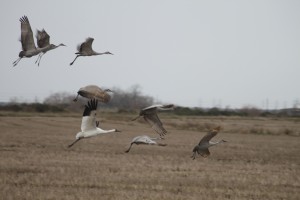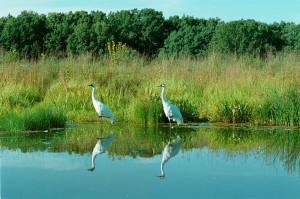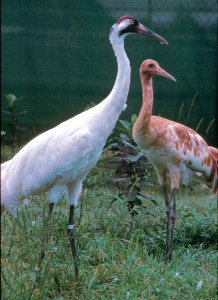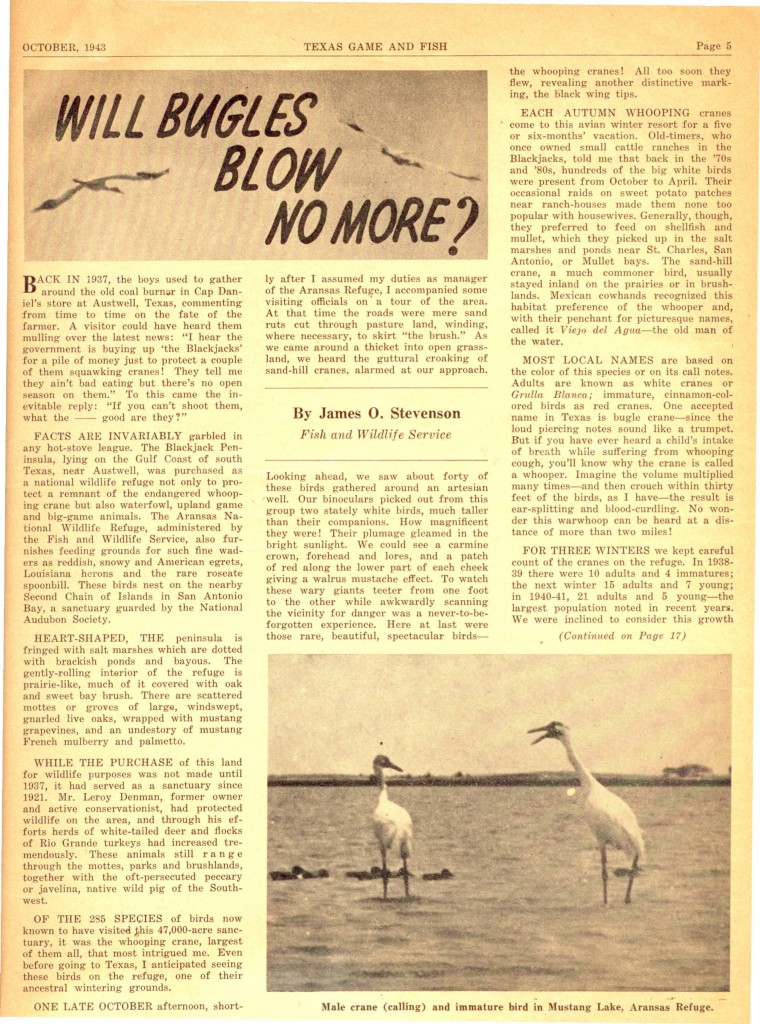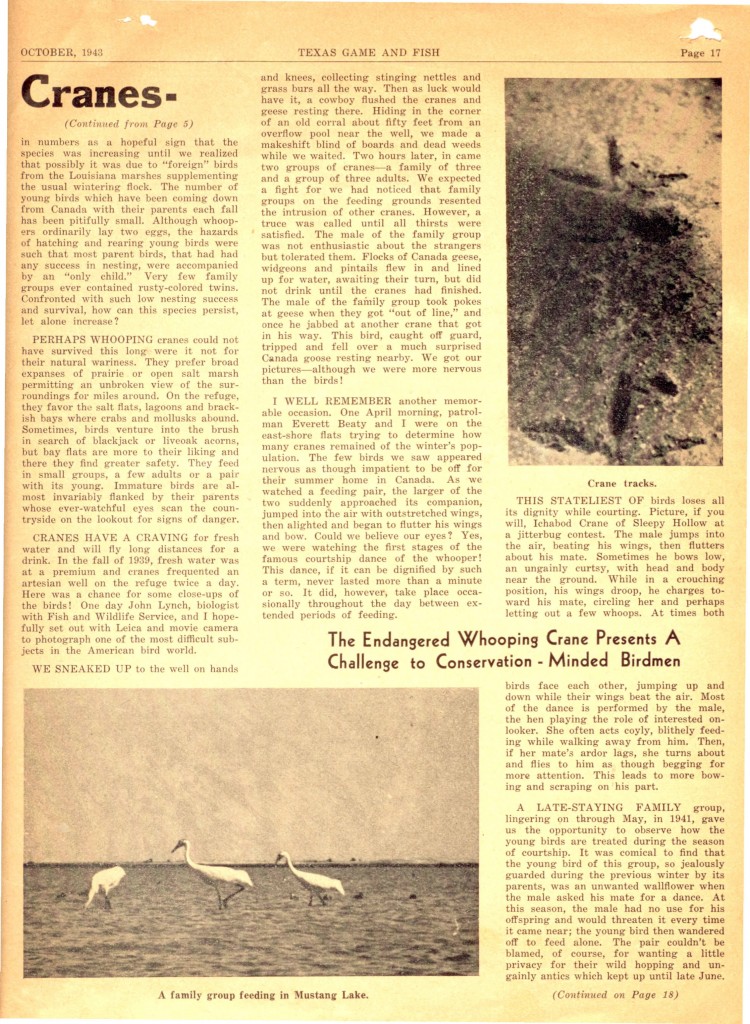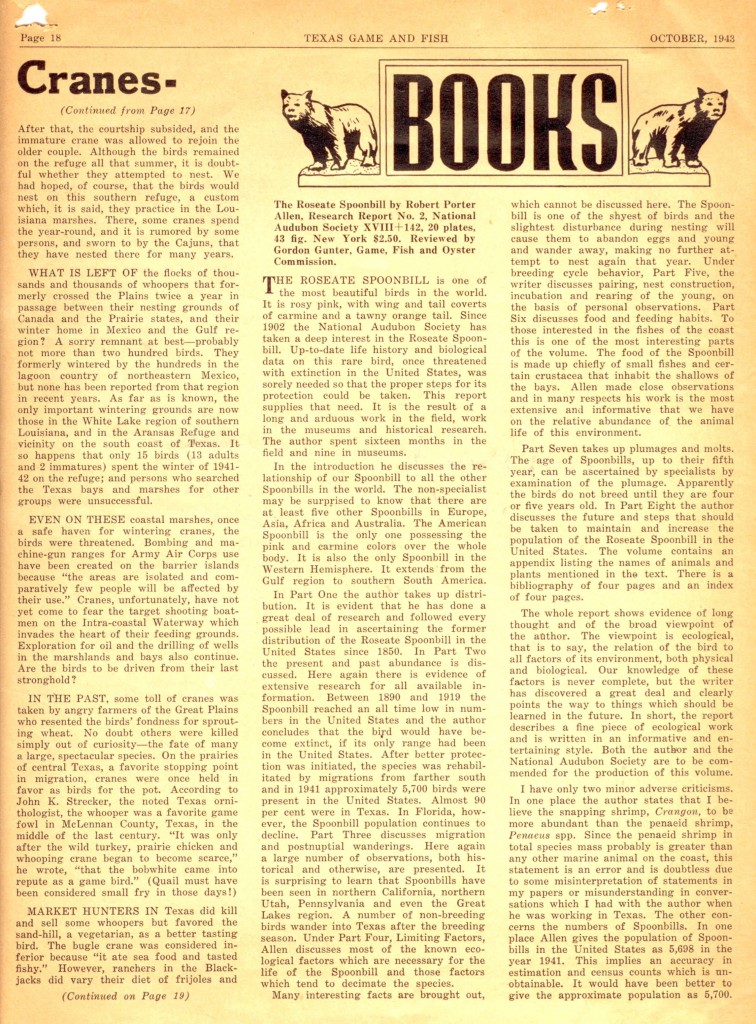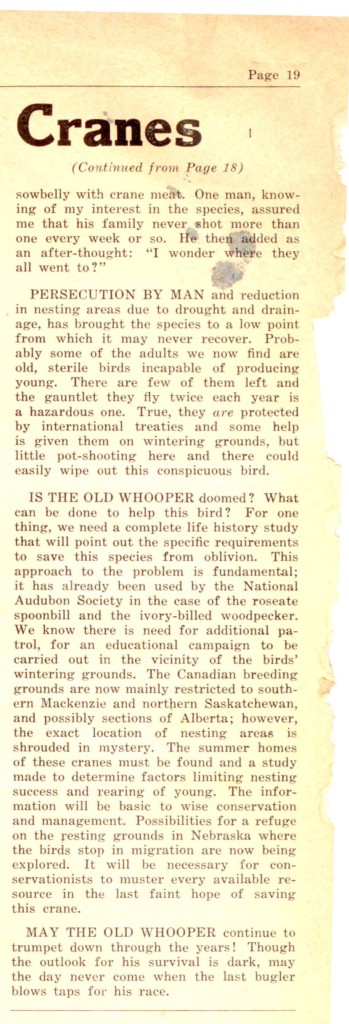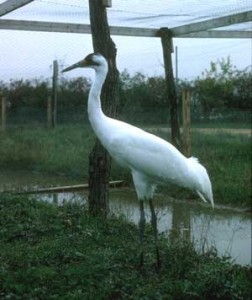Archive for the ‘Flock Status’ Category
Whooping cranes spotted near South Dakota wind project
May 3, 2013 |
|
| Whooping cranes spotted in South Dakota. |
On April 2, a flock of 16 whooping cranes were spotted near the Crow Lake Wind Project in South Dakota. The birds were spotted by one of the wind technicians. Once the cranes were spotted, about three dozen wind towers were immediately shut down. For almost the entire month of April, there were cranes in the area. It was a combination of some leaving, some arriving and some remaining. As the birds moved around the area, towers were shut down as needed.
According to Kevin Tschosik, Basin Electric manager of distributed generation, any wind turbines within a two-mile radius of a crane sighting must be immediately shut down. “During the initial sighting, we shut down 37 of the 108 towers in the park,” he said. “As the birds were moving through the area during the month, various towers were shut down within the two-mile radius and the entire park was shut down a couple of times.”
During the spring and fall whooping crane migration seasons, Basin Electric hires biologists to patrol the Crow Lake wind park, searching for whooping cranes. Tschosik said the Crow Lake wind park boundaries encompass about 35,000 acres, and wind technicians also are on the lookout for cranes. The whooping crane spring migration season begins April 1 and continues through May 15. The fall season begins Sept. 10 and continues through Oct. 31. He said all of the wind technicians at all of Basin Electric’s wind parks participate in annual training to spot and identify whooping cranes.
“This is an example of where our training paid off, and we followed proper procedures to prevent any possibility of injuring a whooping crane due to it flying into a moving turbine blade,” Tschosik said. “The cranes that were observed were spotted by one of our wind technicians who made the call to dispatch and the park manager to start shutting down the towers.”
While the cranes were in the area, the biologists carefully watched and charted their movements from afar taking exceptional care to not spook or harass them, Tschosik said. In addition, regular updates were provided to the U.S. Fish and Wildlife Service to keep them informed of the ongoing bird observations and tower shutdowns.
Whooping cranes are one of the rarest birds in the world with a total population of approximately 600 individuals, with less than 300 in the migratory flock that travels through South Dakota. After being pushed to the brink of extinction by unregulated hunting and loss of habitat to just 21 wild and two captive whooping cranes by 1941, conservation efforts have led to a limited recovery. As of 2011, there are an estimated 437 birds in the wild and more than 165 in captivity. The whooping cranes that travel through South Dakota migrate from wintering grounds along the gulf coast of Texas to the Wood Buffalo National Park located in Alberta and the Northwest Territories of Canada.
Whooping cranes start journey to Wood Buffalo
April 23, 2013by Renée Francoeur
Wood Buffalo National Park’s flock of whooping cranes is headed home to the Northwest Territories.
The Whooping Crane Conservation Association (WCCA)reported last week that approximately 50 to 60 per cent of the cranes had already left their wintering grounds on the Texas coast in the Aransas National Wildlife Refuge.
On Thursday, WCCA’s Chester McConnell said he received word of the first whooping crane sighting of the year in Canada from an observer in Radisson, Sask.
“The citizen who reported (it) advised that one and one-half foot of snow was on the ground, but the whoopers were standing in a dugout,” McConnell said in an email. “Hopefully the Canadian public will be happy that their birds are coming home to nest.”
The birds undertake the 2,500 mile migration each year to nest and rear their young in Wood Buffalo.
US Whooping Crane Recovery Coordinator Wade Harrell monitors the flock in Aransas and reported to McConnell that despite some cranes still being observed on the refuge, the migration is well underway.
While the birds seem to be leaving en masse, they actually have staggered departures and leave in small groups, Harrell related.
Bird watchers can log their crane sightings at https://whoopingcrane.com/report-a-sighting/ .
To see a map illustrating the cranes’ 2013 migratory progress, visit https://whoopingcrane.com/migration/ where observations have been posted since mid March. This map cannot be used to locate the birds as all postings are delayed by at least one week to help prevent harassment of the birds.
Canada is home to the world’s largest migratory population of whooping cranes. According to Environment Canada, there are almost 300 birds in the migratory Wood Buffalo flock.
Whooping cranes were designated as endangered in Canada in the year 2000. The birds are protected by the Migratory Bird Treaty Act and the Endangered Species Act.
Whoopers Continue On Their 2,500 Mile Migration
April 16, 2013by Chester McConnell, Whooping Crane Conservation Association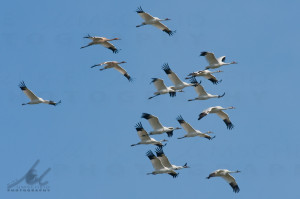
Approximately 50 to 60 percent of the whooping cranes have departed from Aransas Refuge (Texas coast) on their long 2,500 mile migration to Wood Buffalo National Park in Canada. Wood Buffalo is where they nest and rear their young. Dr. Wade Harrell, U.S. Whooping Crane Recovery Coordinator continually monitors the whooper flock on Aransas National Wildlife Refuge. Harrell described the ongoing migration of the birds as normal this spring. He explained that, “Whooping cranes are still being observed on the refuge, but the migration is well underway.
Harrell explained that, “As of Monday, April 8, 14 of the telemetry marked birds that we are actively receiving data on were still present on the Texas coast and 21 have begun migration. Based on this information and other observations, it is likely that greater than 50% of the birds in the Aransas/Wood Buffalo flock are currently migrating north. Of the 21 marked whooping cranes currently in migration, 14 are as far north as Nebraska and the Dakotas.”
Harrell estimates that most remaining birds will depart from Aransas Refuge over the next couple weeks. He advised that, “Whoopers are scattered along the migratory path as far north as North Dakota. Though the birds seem to be leaving in mass, they actually have staggered departures and leave in small groups. This is important as it ensures survival of the species. If they were to all leave together and encountered bad weather or some other catastrophic event, it could put the whole flock in jeopardy.” Dr. Harrell’s migration information mirrors information collected by the Whooping Crane Conservation Association (WCCA). Many bird watchers and a variety of citizens observe whooping cranes and report then on WCCA’s web page https://whoopingcrane.com/ .
Anyone who spots a whooper can go the web page and click on Report a Sighting and complete a simple form. WCCA places the information received on a map during the spring and fall migrations. Anyone can keep up with the migration by clicking on https://whoopingcrane.com/migration/ .
Migration Map
WCCA’s Migration Map includes all creditable whooping crane observations from reports received. Each whooper “icon” on the map represents from 1 to 6 birds. Observations have been posted on the Spring Migration 2013 map since mid-March. Importantly, all postings are delayed at least one week to help prevent harassment of the birds. Because the whoopers move frequently during migration, it is highly unlikely that one can use the map to locate the birds.
Water for Wildlife: The Fate of the Whooping Crane Depends on It
April 13, 2013by Melinda Taylor, University of Texas School of Law*
Texas is entering the third year of a drought that threatens to be worse than the 1950s’ drought of record. Across the state, the reservoirs that supply our towns and support industrial and agricultural demands are at alarmingly low levels, with no relief in sight.
The Texas Legislature is poised to create a fund to help finance conservation measures and new water infrastructure, an important step toward implementing the state’s water plan and ensuring that the water needs of the state’s growing population are met. The fund is the Legislature’s response to the economic impacts of the current water shortages: impacts on agriculture, recreation, and business.
But the drought has exacted a toll on the natural environment, too, causing harm to native and wildlife that is difficult to quantify. The shortage of rainfall has caused disruptions in the normal food chain, affecting everything from bats and birds to squirrels, raccoons, and white-tailed deer.
For the most part, impacts to wildlife take a back seat in the public’s mind to the ramifications for humans if the drought persists. But the interests of humans and wildlife often intersect and can sometimes collide, a point brought home by a federal court’s March 11 order to the Texas Commission on Environmental Quality to stop issuing water permits in the Guadalupe River in order to protect an endangered species on the Texas coast, the Whooping Crane.
On its face, the lawsuit appears to be yet another clash of endangered species versus humans, a Texas version of the spotted owl debate of the 1990s, or perhaps the latest example of federal impingement on Texas’s power to regulate its own natural resources. But, not surprisingly, the truth is more complicated. The reality is that the lawsuit was a last ditch effort to ensure that the Whooping Crane and the beautiful, resilient, finely tuned coastal ecosystem on which it depends can survive over the long run, even as the state grapples with the difficulty of meeting humans’ water needs during times of drought. The remedy ordered by the judge – that the state stop issuing permits to water users until it formulates a plan to protect the bird – is a common sense approach that should lead to a balanced state water permitting program.
The Whooping Crane is a majestic creature, the tallest crane species in North America and the rarest crane in the world. It is also an Endangered Species Act success story. In the 1940s there were fewer than 15 individual Whooping Cranes left in the world. Today, the population is estimated to be more than 500, with the world’s only self-sustaining wild population wintering in south Texas in and around Aransas National Wildlife Refuge. The Whooping Crane feeds on wolf berries and blue crabs, both of which suffer when San Antonio Bay becomes too salty, the result of inadequate freshwater flows into the bay. In 2009, scientists from the U.S. Fish and Wildlife Service, which manages the Refuge, noticed that Whooping Cranes were dying and appeared to be malnourished. They concluded that the birds’ food sources were literally drying up and that the only way to ensure their long term survival was to get more fresh water into the bay.
The Aransas Project, or “TAP,” was formed by conservationists, business owners, and landowners concerned about the Whooping Crane and determined to convince TCEQ to allow more water to flow down the Guadalupe River and reach the bay. They applied for a water permit with the intention of keeping the water they were allocated in the river, rather than pumping or diverting it, but the agency rejected the application. As a last resort, they brought suit under the federal Endangered Species Act, alleging that TCEQ was causing harm to the Whooping Crane by failing to ensure that sufficient freshwater reached the coast to maintain the crane’s food supply.
In December 2011, there was an 8-day trial during which the judge heard evidence from all the parties about all aspects of the case, including the Whooping Crane’s food requirements, the number of birds that live in Texas, and the State’s water permitting program and its ability to manage flows in the Guadalupe. The State and intervenors Guadalupe-Blanco River Authority and the San Antonio River Authority argued that a state law passed in 2009 set up a process by which the state would determine what flows are necessary to protect the state’s rivers, which precluded the need for federal action. But the court found a gaping hole in the state’s position: the state program on its face does not apply to existing water permits, only to new permits. Because the vast majority of water in Texas rivers and streams has been appropriated to water users already, it would be difficult, if not impossible, to secure sufficient flows to protect the Whooping Crane by relying solely on permit conditions in future permits. The court ruled in favor of the plaintiffs in the case and ordered TCEQ to devise a plan to protect the crane.
The Endangered Species Act contains a provision called an incidental take permit that authorizes otherwise lawful activities that cause harm to endangered species. To obtain a permit, a person (or state agency, as in this case) must prepare a “habitat conservation plan” to demonstrate that harm to the species will be minimized and mitigated “to the maximum extent practicable.” In this case, the U.S. Fish and Wildlife Service has pledged to work with TCEQ to develop a plan to protect the Whooping Crane and its habitat in the course of administering the state’s water permitting program. The habitat conservation plan will fill the hole in the state’s program and provide an important safety net for the crane. Rather than resisting all federal involvement, TCEQ should cooperate with the Fish and Wildlife Service and figure out a creative way to ensure the long-term survival of this glorious denizen of the Texas coast.
* Senior Lecturer and Executive Director, Center for Global Energy, International Arbitration and Environmental Law, University of Texas School of Law
Whooping Crane Update – Aransas National Wildlife Refuge (summary)
April 12, 2013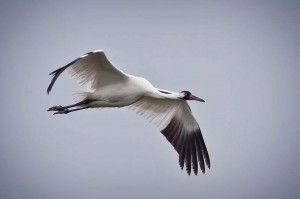 by Wade Harrell, U.S. Whooping Crane Recovery Coordinator
by Wade Harrell, U.S. Whooping Crane Recovery Coordinator
Whooping Cranes on the Refuge:
Birds are still being seen on the refuge, but the whooping crane migration is well underway and we expect that most birds will depart the coast over the next couple weeks. Based on the tracking data and incidental observations, it appears that the birds using the periphery areas of the winter range (i.e. Lamar, Granger Lake, El Campo, Welder Flats) have been the first to depart this year. Though the birds seem to be leaving in mass, they actually have staggered departures and leave in small groups. This is important as it ensures survival of the species. If they were to all leave together and encountered bad weather or some other catastrophic event, it could put the whole flock in jeopardy.
Tracking Efforts:
As of Monday, April 8, 14 of the marked birds that we are actively receiving data on were still present on the coast and 21 have begun migration. Based on this information and other observations, it is likely that greater than 50% of the birds in the Aransas/Wood Buffalo flock are currently migrating north. Of the 21 marked whooping cranes currently in migration, 14 are as far north as Nebraska and the Dakotas
Taking a look into the past as we consider the future:
The following graphic shows the expansion of wintering whooping cranes on and around the Refuge over the past 55 years (1951-2006). As we have seen this winter, this expansion has now moved to a few inland locations such as the Granger lake area. This trend gives us hope that the species will continue on the upward trend. To read the full report, click on: http://www.fws.gov/nwrs/threecolumn.aspx?id=2147517593
Water, Whooping Cranes, and the ESA
April 5, 2013by Dave Owen, Associate Professor of Law, University of Maine School of Law*
Three weeks ago, a federal district court in Texas issued an important ESA decision. The Aransas Project v. Shaw also is a very long decision—124 pages, to be exact—so I’ve been a bit slow to get a blog post up. Despite its daunting length, the case is important reading for anyone interested in water management or the ESA. It’s also a rather intriguing case study of the use—both successful and badly botched—of expert testimony in environmental litigation.
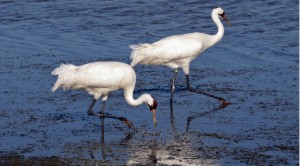 The case arises out of water management controversies in Texas. According to the plaintiffs, the Texas Commission on Environmental Quality and its fellow defendants had taken whooping cranes in violation of section 9 of the Endangered Species Act. They had done this, the plaintiffs argued, by allowing excessive water withdrawals from the river systems that feed into the Aransas National Wildlife Refuge, which provides vital whooping crane habitat. The court agreed, enjoined the issuance of new water permits, and ordered the defendants to prepare a habitat conservation plan and seek an incidental take permit.
The case arises out of water management controversies in Texas. According to the plaintiffs, the Texas Commission on Environmental Quality and its fellow defendants had taken whooping cranes in violation of section 9 of the Endangered Species Act. They had done this, the plaintiffs argued, by allowing excessive water withdrawals from the river systems that feed into the Aransas National Wildlife Refuge, which provides vital whooping crane habitat. The court agreed, enjoined the issuance of new water permits, and ordered the defendants to prepare a habitat conservation plan and seek an incidental take permit.
That’s a very interesting outcome, because successful section 9 actions against water managers don’t seem to be particularly common. I haven’t done any sort of rigorous survey, but my impression, based on working as a water lawyer and then on my academic research into related ESA questions, is that environmental groups have gained much more leverage through ESA section 7. Indeed, in the Southeast’s longstanding Apalachicola-Chattahoochee-Flint controversy, similar take claims brought against upstream water managers failed. See Alabama v. Army Corps of Engineers, 441 F. Supp. 2d 1123 (N.D. Ala. 2006) . So could this case signal the emergence of a new front in the ESA/water allocation wars? My suspicion is that several factors will make these plaintiffs’ success difficult to replicate. In no particular order, those factors are:
The extraordinary level of data available to the plaintiffs in this case. Reading the opinion made me wonder if these whooping cranes are one of the most carefully observed wild animal populations on earth. As the court describes, scientists have been counting whooping cranes since the 1950s. Since the early 1980s, scientists—including one of the plaintiffs’ experts—have conducted dozens of monitoring flights every year. The resulting level of information is exceptional. Usually population biologists must rely on some combination of observational data (usually limited), proxy indicators like habitat conditions, and computer-based modeling to assess the status of a population. The resulting uncertainties can limit plaintiffs’ ability to demonstrate causal relationships with enough certainty to support a successful ESA section 9 claim. With whooping cranes, the circumstances are quite different.
The imbalance of experts. The plaintiffs had an impressive array of experts on their side. Here’s the court’s description:
At trial, TAP presented seventeen witnesses, ten of whom were experts, GBRA eight; SARA one: and TCEQ two. As will be discussed in more detail later, TAP’s experts were world renowned in their respective fields. Several of TAP’s witnesses hold endowed chairs at prestigious universities, some are MacArthur Fellows, all have published numerous scientific papers in respected journals. Indeed, one witness, Dr. Ronald Sass, is a shared recipient of the 2007 Nobel Peace Prize for his environmental work. TAP’s crane experts… have years of study in the field and have devoted their time and energies to the survival of the AWB species. All of TAP’s experts were accepted as such and the Court finds their testimonies compelling and credible.
The court had less laudatory things to say about the defendants’ experts. For example:
Dr. Slack did not personally spend any significant amount of time in the field, averaging one day per year over the past fifteen years. Contrary to the scientific literature, Dr. Slack testified that cranes did not need freshwater because they had functioning supraorbital salt glands which allowed them to secrete excess salt. However, when questioned further by the Court, Dr. Slack admitted that he had no observational basis for this statement, he had not reviewed literature on cranes and freshwater, and that he “just made it up.” (record citations omitted)
The level of judicial interest. From the outset, the narrative structure of the opinion (yes, it does have a narrative structure) strongly suggests that someone in the court’s chambers cared very deeply about this case, and probably also about whooping cranes. Before getting into the procedural history, relevant law, or even the identities of the parties, the opinion spends several pages describing the whooping crane die-off, much like a detective novel beginning with the key murder. But the real tip-off comes later, in a remarkable passage debunking the work of one of the aforementioned Dr. Slack’s graduate students:
[A key defense report] used a report by Dr. Slack’s graduate student Danielle Greer whose conclusions to the preferred food of whooping cranes was (sic) based on 90 plus hours of video of three crane areas. The Court watched all of the videos and finds that they were either too blurred to see anything or non-demonstrative of any habit, feeding or otherwise.
So what does this all suggest? If I’m reading correctly, it shows that when plaintiffs have extraordinarily good monitoring data, an all-star team of experts, poorly prepared experts on the other side, and a judicial chambers where someone—perhaps the judge, more likely a clerk—cares so deeply that she is willing to watch 90 hours of blurry footage of whooping cranes, they can win an ESA section 9 case against upstream water managers. Absent those circumstances, the challenge might be a bit harder. That doesn’t mean there won’t be other cases like this. Conflicts between water withdrawals and the needs of endangered fish and wildlife probably aren’t going away any time soon. But the case does illustrate the level of scientific and legal work necessary for plaintiffs to prevail.
* Dave Owen’s article is re-posted from Environmental Law Prof Blog, A Member of the Law Professor Blogs Network
Transmitters allow Crane Trust scientists to follow whooping cranes during migration
March 21, 2013Posted with permission of KearneyHub.com
By LORI POTTER Hub Staff Writer , Posted: Friday, March 8, 2013 2:00 pm
Whooping Crane Tracking Partnership
Whooping crane
A juvenile whooping crane wears a transmitter with a global positioning system that identifies its location four times daily for researchers at the Crane Trust near Alda and along the Central Flyway from Texas to Canada. There now are transmitters on 35-40 of the 279 migrating whooping cranes. Rick Rasmussen, Platte River Photography Crane Trust officials are asking the public to assist with Whooper Watch during the spring migration season. Adult whooping cranes are white with black wingtips. Visit the website at www.nebraskanature.org for details.
ALDA — Whooping cranes wearing solar-powered transmitters tell researchers at the Crane Trust near Alda and throughout the Great Plains states and Canadian provinces where the birds stop during spring and fall migrations.
But it’s still up to scientists on the ground to fill in the details.
“Where we’re taking a leading role is evaluating the stopover locations on the Central Flyway,” said Crane Trust Director of Science Mary Harner.
“It’s a big thing in science now,” Crane Trust Wildlife Biologist Greg Wright said about tracking wildlife with global positioning systems, “but it only goes so far … So you have to be there.”
Wright and other biologists go to the GPS-identified stopovers to make detailed surveys of the land cover and other habitat features, and to talk to landowners. “Teams are scattered (throughout the flyway), so someone always is relatively close and you can get there in good time,” he said.
The Whooping Crane Tracking Partnership began in 2008 as a research project conceived byCrane Trust staff, with support from U.S. GeologicalSurvey, to use a transmitting system to identify migration pathways.
Data gathering started in 2009 when the first whooping cranes were captured at wintering areas at Aransas National Wildlife Refuge in south Texas and breeding sites at Wood Buffalo National Park in Canada. The captures were authorized by the U.S. Fish and Wildlife Service and Canadian Wildlife Service.
Each captured bird is given a health check. Platform transmitting terminals with GPS systems and antennas are attached to their legs.
Harner said Neoprene is used on the inside of the devices as a cushion between them and cranes’ legs.
There are solar panels on the three exposed surfaces of the two-piece leg bands to maximize recharge of batteries that are expected to have a lifespan of three to five years.
Wright said there now are 35 to 40 whooping cranes with transmitters. “This technology was thoroughly researched on sandhill cranes before it was used on whooping cranes,” he added.
Harner said the project has collected a little over half of the location data that is expected over the duration of the research. The Crane Trust website says researchers expect to follow the birds in the field through 2015.
A February 2013 USGS report for the five core project partners — the others are the Crane Trust, Canadian Wildlife Service, Platte River Recovery Implementation Program and USFWS — summarizes the project’s history and data from 2012.
Location data was gathered for 36 whooping cranes during the 2012 summer breeding season in
Canada. During last fall’s migration, 261 stopover locations were documented, including one east of Lexington, one east of Kearney and one east of Wood River.
The report says 11 adults and one juvenile whooping crane were captured at Aransas this winter and the plan is to capture 10 more adults during winter 2013-2014. It also says that during the project’s lifetime, the goal is to have transmitters on about 30 juvenile (hatch-year) birds and 30 adults.
The project goals listed by the five core partners in a 2011 research partnership document are to advance knowledge of whooping crane breeding, wintering and migratory ecology; disseminate research findings for conservation, management and whooping crane recovery; and minimize negative effects of research activity on the cranes.
Other organizations supporting the project are the Gulf Coast Bird Observatory, International Crane Foundation and Parks Canada.
“Partners agree that this opportunity to mark wild whooping cranes with GPS technology represents the best prospect in the past 30 years to enhance understanding of whooping cranes and assess risks they face during their entire life cycle,” the USGS report says.
Wright said the cooperation of landowners where whooping cranes have been spotted has been a wonderful asset to the research.
“We’re certainly learning things,” he said, but the data collected so far is a small sampling of what researchers will have in the next year or two. “There’s really not a precedent for this.”
Harner said transmitters are activated immediately after they are placed on the cranes and are programmed to record four GPS locations daily, once every six hours.
There is a time lapse because transmitters upload new data approximately every 2½ days. Researchers are dispatched to survey the places where it’s known that whooping cranes have been.
Wright said that once the signals are downloaded, a decoding program must be used “so it means something to us.”
“Project partners monitor the whooping crane location data closely as the project continues,” Harner said, “and we will be working together over the next several years to continue collecting, processing and analyzing the data, and sharing research findings.
“Far-reaching partnerships make this landmark study successful, and we look forward to ongoing collaborations to advance our understanding of this magnificent species.”
email to: lori.potter@kearneyhub.com ________________________________________
WHOOPING CRANE FACTS, Whooping Crane (Grus americana)
Features: Tallest bird in North America, at 5 feet. Mostly white with black wingtips and face, and red head.
Numbers: Approximately 280 in a migratory flock that breeds in Wood Buffalo National Park in Canada and winters at Aransas National Wildlife Refuge in south Texas. In captivity or part of re-introduction efforts, 290.
History: There are accounts of whooping cranes seen during spring and fall migrations since European settlers arrived in Nebraska in the 1840s.
Lowest numbers: Due to hunting and habitat loss, only 15 birds remained in 1941.
Recovery challenges: Loss of habitat, altered wetlands, climate change and collisions with power lines.
Breeding: Whooping cranes normally lay two eggs, with one egg-chick surviving. Adult pairs have been seen with twins, including five sets arriving at Aransas in 2010.
Behaviors: Territorial at breeding and wintering grounds, and use the same areas year after year.
Migration route: About 2,500 miles long and 300 miles wide through Texas, Oklahoma, Kansas, Nebraska, South Dakota, North Dakota, Saskatchewan and Alberta.
Critical habitat: Four sites designated in the 2005 International Recovery Plan for the Whooping Crane are Salt Plains NWR in Oklahoma, Cheyenne Bottoms State Waterfowl Management Area and Quivira NWR in Kansas, and the Platte River between Lexington and Denman. ________________________________________
Whooper watchers still sought
ALDA — Crane Trust officials are seeking public help to spot endangered whooping cranes during their spring migration through Nebraska in March and April.
If you see a whopping crane, call Whooper Watch at 888-399-2824 to report the time, exact location, crane numbers and activities.
A scientist will be sent to confirm the sighting and document location features.
Do not disturb the birds. Stay in a vehicle or established viewing area at least 2,000 feet (0.4 of a mile) away. Don’t tell others of the sighting or location to avoid attracting more attention.
There are only about 280 whooping cranes in the wild flock that winters in south Texas and goes to summer breeding grounds in Canada’s Prairie Provinces. During their 2,500-mile spring and fall migrations, they may stop for one to several days along the Platte or other Nebraska rivers and wetlands to rest and feed.
Visit the website at www.nebraskanature.org to download a flyer that includes bird identification information and Whooper Watch rules and procedures.
Dallas Man Convicted and Fined for Killing Whooping Crane
March 7, 2013by Chester McConnell, WCCA
Worthey D. Wiles, 42, of Dallas, has entered a plea of guilty and was sentenced for killing a whooping crane .Wiles killed the whooping crane on January 12, 2013. The announcement was made by United States Attorney Kenneth Magidson today along with Nick Chavez, special agent in charge of U.S. Fish and Wildlife Service (FWS).
Wiles was a guest hunter at the St. Charles Bay Hunting Club in Rockport which is located inside the designated critical habitat for whooping cranes. While hunting in the marsh adjacent to San Jose Island, Wiles shot and killed a juvenile whooping crane. After contacting Texas Parks and Wildlife (TPW), Wiles told state game wardens he thought the whooping crane was a Sandhill crane. Wardens then contacted FWS who located the bird and verified it was a whooping crane.
Even though Wiles believed he was shooting a Sandhill crane, hunting for them is illegal near San Jose Island where the bird was killed and throughout the whooper’s traditional wintering habitat centered on the Aransas National Wildlife Refuge north of Rockport.
“The whooping crane is one of the most beautiful and highly valued species of America’s wildlife heritage,” said Chavez. FWS is committed to protecting this extraordinary bird so that future generations of Americans are able to marvel at its grace and beauty.”
Wiles, a Dallas duck hunter shot and killed one of the juvenile cranes that had hatched and been reared by its wild parents during the summer of 2012 on Wood Buffalo, Canada nesting grounds. The young whooping crane was one of only 34 produced in Canada in 2012 and was killed during its first visit to the Texas coast. It had successfully completed its first 2,400 mile migration from Canada to Texas. Young whoopers have a potential life span of 40 or more years if they remain healthy. The Whooping Crane Conservation Association asserts that even the loss of one crane from the approximate 300 wild whoopers in the world is a serious tragedy.
Whooping cranes are one of the rarest birds in the world with a total population of approximately 437 cranes in the wild and 599 overall. The whooping crane population that winters in Texas is the only self-sustaining wild population of whooping cranes in the world. This case is only the fifth known shooting death of a whooping crane since 1968. Killing one of the approximate 300 wild whooping cranes that migrate from Canada to Texas is a federal violation of the Endangered Species Act. Punishment spans a broad range of fines, restitution fees and prison terms. Under the federal Endangered Species Act it is a crime to harm, harass or kill a federally-protected species. Violators face fines of up to $250,000 and up to one year in jail.
Today, when Wiles appeared before United States Magistrate Judge B. Janice Ellington, he entered a plea of guilty to one count of violating the Migratory Bird Treaty Act, which provides protection for Migratory Birds. As a result, he was ordered to pay a $5,000 fine and make a $10,000 community service payment to the non-profit organization Friends of Aransas and Matagorda Island National Wildlife Refuges. He will also serve a one-year-term of probation for his conviction. The Whooping Crane Conservation Association stated it is pleased that a $10,000 community service payment is going to Friends of Aransas and Matagorda Island National Wildlife Refuges. The organization performs valuable voluntary services for the refuge.
In a recently settled case, a South Dakota man who shot and killed a whooping crane was ordered to pay $85,000 in restitution and serve two years’ probation. He was also required to surrender his firearms used in the offense and will lose his fishing, hunting and trapping privileges anywhere in the United States for two years and pay a $25 assessment to the Victim Assistance Fund. A Whooping Crane Conservation Association spokesman said restitution should be a minimum of $150,000 based on the amount of time, effort, research, land costs, law enforcement and other expense that goes into nurturing and protecting these iconic birds. Likewise, the Association believes jail time should be imposed on violators to let it be known that such crimes are serious.
The Aransas County death is the fifth known Texas case involving the shooting of a whooping crane since 1968, though another crane death in Calhoun County remains under investigation. Previous Texas cases from 1989 and 1991 ended in fines totaling $21,000 and $23,100 respectively.
Will Bugles Blow No More?
March 4, 2013Editor’s note: Pam Bates, historian with the Whooping Crane Conservation Association, enjoys searching old files for interesting information about whooping cranes. We have posted several of her finds on this web page for your information and reading pleasure. Pam recently located an article titled “Will Bugles Blow No More?” written by James Osborne Stevenson in the Texas Game and Fish newsletter.
James Osborne Stevenson became the first refuge manager of the Aransas National Wildlife Refuge in Texas under the Bureau of Biological Survey. There he spent much of his time observing, studying, and photographing whooping cranes. He took the first ever color films of their courtship dances, and published a number of scientific and public interest articles on these cranes. In 1943, he published an article called Will Bugles Blow No More? about their endangerment. Jim died of a stroke on October 14, 1991.
If you have problems reading the article, double-click on the articles to enlarge the print.
CANUS – 186 whooping crane descendants
February 25, 2013Editor’s note: The Whooping Crane Conservation Association (WCCA) has received several inquiries during the past year quizzing us about why we believe whooping cranes are so cherished. One person wrote “who gives a dam about whooping cranes?” Answers to questions like these are not easy when you are responding to someone who is not interested in the natural world and all its wonders. Probably the best answer was written by Aldo Leopold in “A Sand County Almanac” -“There are some who can live without wild things, and some who cannot.” To further answer the questions, I reviewed a story we printed about Canus the whooping crane in “Grus Americana” (WCCA’s newsletter) in May 2003. A more detailed article about Canus appeared on Patuxent Wildlife Research Center web page. The article is posted below to provide an example of the “value” of one whooping crane and the people who cared for him. Hopefully this article will be read by a diverse group of people including United States Attorney’s, federal judges, wildlife law enforcement personnel, wildlife biologists, news reporters and citizens interested in whooping cranes:
CANUS and his 186 whooping crane descendants (1964 – 2003)
– USGS Author unknown. Written in 2003 –
To anyone who cares about endangered species, information about their numbers is always important. For whoopers, the rarest of all cranes, the annual count has been an environmental cliff-hanger for decades. In 1938, they were down to only 18 birds in the Aransas-Wood Buffalo flock, with only 11 remaining in the non-migratory Louisiana flock. Ten years later there were 31 birds in the Aransas-Wood Buffalo flock, but the Louisiana flock was down to a single bird. By 1950, the Louisiana flock was gone. The Aransas-Wood Buffalo flock’s numbers hovered on the edge of disaster for another decade. By 1964, there were still only 42 whooping cranes in the wild.
So, when a biologist doing aerial surveys in 1964 at Wood Buffalo Provincial Park (in Saskatchewan and Northwest Territories, Canada) discovered a young-of-the-year chick with a broken wing, he quickly took action. The chick’s parents were aggressive, rushing the helicopter when it came too close. The biologist knew that the parents could keep the chick safe from predators, but soon they would have to migrate, and their chick wouldn’t be able to follow them. He wouldn’t survive long once they were gone.
The biologist contacted officials in Canada and the US, and was advised to capture the bird. They did so the next day, chasing the chick through the marshland until it tripped on its dangling primaries and fell. The young crane, once captured, offered surprisingly little resistance. An x-ray showed a 2 inch sliver of charred wood had pierced the bird’s breast muscle and his wing was partially dislocated. They speculated that he had struck a burnt tree during early flight practice. To everyone’s surprise, the young crane showed no fear of his captors and readily accepted food including smelt, mealworms, hamburger and minced eggs.
The injured chick was later transferred to Monte Vista National Wildlife Refuge, Colorado where he did well until he suddenly became ill. Four veterinarians were brought in and treated the bird, who seemed near death. Amazingly, within a day the crane seemed to recover. But his bout of bad luck wasn’t over. While exercising in his pen one morning, he caught a toe in the bandage on his injured wing and fell, breaking the wing in two places. Again, the vets repaired the wing and he again recovered. It was shortly afterward that this young crane would be given the name “Canus” — CAN for Canada and US for the United States. A leg band was attached with the number “02-64001”.
In 1966, 02-64001 was transferred to what was then the beginnings of the U.S. Fish and Wildlife Service’s endangered species captive propagation program at the Patuxent Wildlife Research Center. 02-64001 was the first whooper in the program, and would become, over his long life, the foundation sire of the captive flock. His adjustment to life in captivity was a major factor in his ability to thrive in this new environment. Unlike many wild-caught animals, he never showed fear of his caretakers, and once he matured, would be quite aggressive to them, especially during breeding season.His injured wing would eventually be amputated. Without two fully functional wings, 02-64001 could not breed naturally. And so the biologists at Patuxent developed an Artificial Insemination (AI) program so that Canus, and other whooper males who were not fully-flighted, could reproduce. With such small numbers, every individual whooper was genetically valuable. As Patuxent’s endangered species program developed, eggs from Wood Buffalo were brought here to hatch, to develop a captive breeding flock that would genetically represent the wild flock in Aransas. This captive flock would be a safeguard — a genetic back-up — in case disaster wiped out the remaining wild birds.
Those early years were devoted to building the breeding flock and learning how to propagate whooping cranes. All the while, the numbers in the wild crept up slowly but surely. In 1966, when 02-64001 came to Patuxent Wildlife Research Center, there were 43 birds in the wild. In 1976, there were 69. Meanwhile, the scientists at Patuxent were discovering just how much there was to learn about the care, feeding, and propagation of whooping cranes.
All through the growth of Patuxent’s breeding flock, the development of proper incubation techniques, the perfecting of AI, the development of health care protocols, nutritional formulas, medical techniques, and chick rearing techniques, 02-64001 was there. Because he was such a long-term subject for Patuxent’s experiments, he literally taught us much of what we know about successful husbandry and breeding of captive Whooping cranes. He sired chicks with his mate through artificial insemination, and his semen was used here on many other female whoopers. It was even shipped, cryogenically preserved, to other facilities with whooping crane females.
Over the years, Canus and his mate raised many chicks together, and were fiercely protective parents. He was surprisingly healthy, after his initial rocky start, but he did have a bout of illness during the 1980s that he recovered from, and in the last five years he had some minor problems due to arthritis in his spine. We moved a panel heater into his pen in the hopes that would help and it may have, but we never actually saw him use it. He always knew when he was being observed. At the first site of humans approaching his pen, 02-64001 and Mrs. C would start going through their threat displays, letting everyone know that if they were thinking of coming in his pen, there would be trouble!
We first wrote about 02-64001 in these reports in June, 2000. At that time, we were following the progress of a young chick destined to be released in Florida, and 02-64001 was that chick’s grandparent. We also talked about some of Canus’ offspring who were now breeding adults in our program such as 02-84003 and 02-85001, our most productive pair, and also 02-83004 and 02-83003. Last year, we reported on Lucky, the first chick to fledge to wild whooper parents in the United States in 60 years — Lucky is a great-grandchild of Canus.
Over the course of his long life, 02-64001 was responsible for 186 whoopers, as sire, grand-sire, great-grandsire and beyond. That’s four times the number of whoopers who were alive the year he was captured. His descendants today are flying free from Wisconsin to Florida and reproducing naturally in the wild in Central Florida. Today, there are nearly 420 whooping cranes in the world — ten times as many as the year he was captured. 02-64001 was no small part of that. ( Approximately 600 whoopers exist in 2013 in the wild and I captivity.)
Early in the morning of Saturday, January 18, 2003, 02-64001 was found down in his feedshed near his heater. The technicians, Barb and Brian, experienced in emergency crane care, rushed him to the veterinary hospital on Center, and after placing him in a heated pen, contacted both the veterinarian on duty, Dr. Patty Bright, and our regular veterinarian, Dr. Olsen, who was attending crane meetings in California. In a short time, 02-64001 began to rally, lifting his head, looking around, and even attempting to stand. 02-64001 was only a few weeks shy of 39 years, and had had other sudden bouts of illness, but had always recovered, so we had hopes that this would follow that pattern. Dr. Bright treated 02-64001 with injectable fluids and steroids, and consulted with Dr. Olsen about an appropriate treatment regimen for the next few days. They decided to also administer antibiotics, and continue fluids and steroids until the bird was well enough for diagnostic blood work, which might tell them more about the nature of the problem.
Unfortunately, despite Canus’ attempt to rally, he died during treatment a few hours later. It was a terrible shock to all of us. In spite of his age, 02-64001 had always fought back against the odds and had always been so strong– it was hard to imagine anything defeating him.
To the people who care about the fate of endangered species, the numbers of animals is a natural focus. How few, how many. For those of us who work with these rare animals, each individual under our care is special, unique to themselves, and valuable. In the course of our daily work, we discover their personalities, their individual quirks, and become totally involved in their welfare and that of their offspring. In many ways, 02-64001 embodied our mission — he survived against incredible obstacles, thrived, and showed a wonderful spirit and will to live. Even while we grieve his loss, we have to celebrate the success that was his life. And in the offspring he has left us, he’ll live on, both here at Patuxent, and free in the wild.
UPDATES
Lucky, the whooper who fledged this year (2003) to wild parents in central Florida (these birds are part of the non-migratory flock that lives in Florida year round), has separated from his parents and is living on his own. It’s normal for young birds to separate from their parents a few months before breeding season. Lucky is associating with wild sandhills and whoopers, and picking good habitat. He has his own radio transmitter so that the Florida biologists can keep track of him. He should be almost completely white by now. * Unfortunately, Lucky was killed by a bobcat in 2010. To see a two part video about Lucky click on: https://whoopingcrane.com/whooping-crane-videos/ Then select “Lucky the Whooping Crane” (be sure and watch both Parts 1 and 2).
After reading the article and viewing “Lucky the Whooping Crane”, we trust that you will understand why many cherish these birds.

